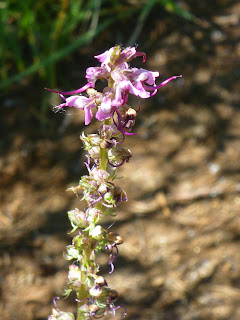Elephant's heads grow in moist mountainous area such as the Tahoe Meadows south of Mount Rose and Relay Peak in the Carson Range, where they can be found during summer months in forest openings of the Loop Trail System including the Interpretive Loop Trail. Flowering plants are easily recognized by their purple-pink, bilaterally symmetrical corollas. The upper corolla lip curves upward, resembling a beak or trunk. The top picture shows such a beak with the stigma protruding through its tip. The common plant name is explained by the combined appearance of this tiny trunk and the lateral flower lobes shaped like miniature elephant ears: elephant's head, also elephant head. Typical plants grow erect and have long, fern-like leaves (picture below), pinnately divided into sharp-toothed lobes [1].
Two elephant head species occur together in Oregon's Cascade Range and in the Sierra Nevada: Pedicularis groenlandica (elephant head, bull elephant's-head or elephanthead lousewort) and Pedicularis attollens (little elephant head or little red elephant) [1,3]. The interpretive panel for the Interpretive Loop Trail indicates the occurrence of P. groenlandica in the Tahoe Meadows—that species that also is found in arctic regions of Canada and Greenland (hence its scientific name) [4-7].
Both P. groenlandica and P. attollens are pollinated by bumblebees (Bombus species): the former by dorsal (nototribe) pollination, the latter by forehead pollination [2,3]. These two angiosperm species make an interesting example for plant-insect coadaption combined with plant speciation. The Pedicularis-type pollination mechanism has been described by Verne Grant [3]:
Pedicularis groenlandica and P. attollens grow and flower together in the same alpine meadows in the Sierra Nevada, CA. Both species are pollinated by bumblebees but are mechanically isolated [...]. The mechanical isolation is reinforced by strong ethological isolation based on flower constancy. Individuals of Bombus bifarius distinguish the two Pedicularis species by their floral features. Some individual bumblebees visit P. groenlandica selectively, bypassing plants of P. attollens in their rounds, while other individual bees forage exclusively on P. attollens. Lapses of flower constancy in which an individual bumblebee crosses over from one Pedicularis species to the other occur but are rare.
Pedicularis-type pollination works via a mechanism that “isolates” plants into (sub)species: the contrasting elephant head species are both pollinated by the same pollinator species (Bombus bifarius and B. flavifrons), but pollen are deposited and picked up on different parts of the bumbleebee's body depending on the particular Peducalaris species.
Keywords: bumblebee flowers, pollination ecology, reproductive isolation, evolution, botany, northwest Nevada.
References and more to explore
[1] Richard Spellenberg: North American Wildflowers, Western Region. Alfred A. Knopf, New York, 2001; pages 770-771.
[2] Lazarus Walter Macior: The pollination ecology of Pedicularis (Scrophulariaceae) in the Sierra Nevada of California. Bull. Torrey Bot. Club April-June 1977, 104 (2), pp. 148-154 [www.jstor.org/discover/10.2307/2484360?uid=3739824&uid=2&uid=4&uid=3739256&sid=21102474310391].
[3] Verne Grant: Modes and origins of mechanical and ethological isolation in angiosperms. Proc. Natl. Acad. Sci. USA January 1994, 91, pp. 3-10 [www.pnas.org/content/91/1/3.full.pdf].
[4] Plant Life: Elephant Head, Pedicularis groenlandica Retz. [montana.plant-life.org/species/pedi_groenla.htm].
[5] USDA Plants Database: Pedicularis groenlandica Retz., elephanthead lousewort [plants.usda.gov/core/profile?symbol=PEGR2].
[6] USDA Plants Database: Pedicularis groenlandica Retz., Elephant's Head [ucjeps.berkeley.edu/cgi-bin/get_JM_treatment.pl?7177,7471,7479].
[7] Laird R. Blackwell: Tahoe Wildflowers • A Month-by-Month Guide to Wildflowers in the Tahoe Basin and Surrounding Areas. A Falcon Guide, Morris Book Publishing, LLC, 2007; page 70.



No comments:
Post a Comment